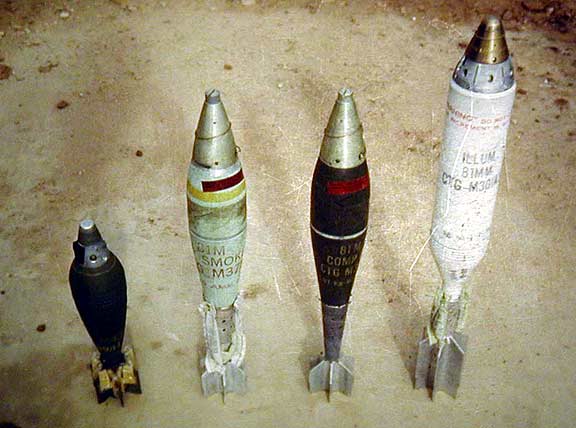 MORTAR
ROUNDS
MORTAR
ROUNDS
photo from Skee descriptions from Taylor
Photo L-R:
1. Old HE rounds from WWII
(I swear !!) Used them up on defcons & practice but wouldn't have trusted them in a situation- altho I don't remember any misfires w/ them. (Skee)
2. Smoke (WP)
rounds were used to mark targets. It was easier to see where the round
hit than a HE round. Adjustments were made on the mortar to make the
round hit exactly. We would then follow up with HE to blow the target
up. Smoke could also be used to mark a target and then jets or gun ships
would attack the area. Troopers note from Skee: Geneva Convention allowed their use for marking rounds only ... like we cared....Jim Good was watching thru his tank sight as my 1st "marking round" landed in the middle of 3 NVA....marked their butts but good!
3. The high explosive (HE) round could be set on HE quick or HE
delay. The quick setting was the default. The delay setting was used in
a canopy type jungle or for dropping the round on a building. The round
had a slight delay for detonation. There were 9 bags of powder on the
bottom of the round, just above the fins. Charge 9 had a range of over 3
miles and charge 0 could be dropped at very close range. The bags were
ripped off and discarded during a fire mission. The round was the main
stay of the mortar.
4. Illumination rounds were fired the
same way except the nose-piece contained a timer. The distance was
determined and looked up on the chart. The information given was the
charge, elevation for the sight and an amount of time to set the fuse.
The round would fly until the time elapsed causing the parachute to
deploy and the charge to detonate, illuminating the area.
WP:
meant white phosphorus a particularly nasty type of incendiary that
looked like a puffy cloud with harmless looking "fingers" emanating from
the explosion. If it ever got on your skin, it would burn to the bone,
and water didn't affect it at all. Usually used as a marker for air
support or prior to firing volleys of HE.
 MORTAR
ROUNDS
MORTAR
ROUNDS